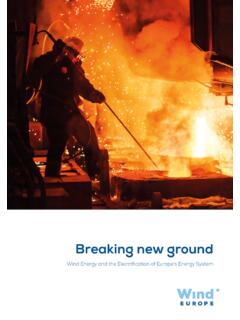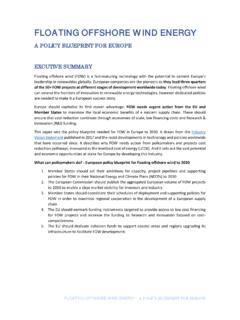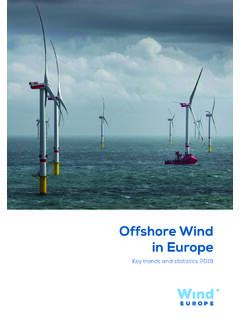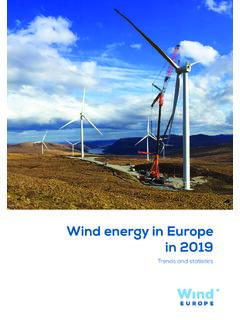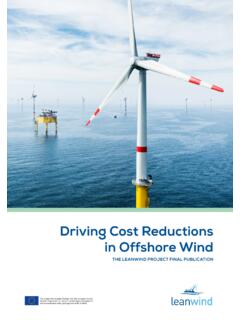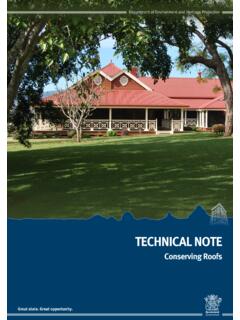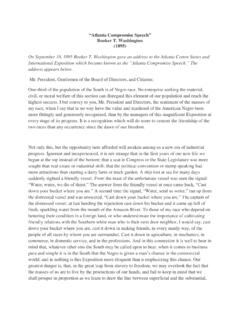Transcription of Accelerating Wind Turbine Blade Circularity
1 Subtittle if needed. If not MONTH 2018 Published in Month 2018 Accelerating Wind Turbine Blade Circularity May May 2020 Accelerating Wind Turbine Blade CircularityTEXT AND ANALYSIS: Marylise Schmid, WindEurope Nieves Gonzalez Ramon, CeficAnn Dierckx, CeficThomas Wegman, EuCIAEDITORS: Daniel Fraile, WindEuropeColin Walsh, WindEuropeDESIGN: Lin van de Velde, DrukvormPHOTO COVER: Damon HongMORE 2 213 18 11 This report has been jointly prepared by WindEurope, Cefic and EuCIA through a collaborative cross-sector platform on wind Turbine Blade recycling. Notably, the report: describes wind Turbine Blade structure and material composition; highlights the expected volumes of composite waste, including wind Turbine Blade waste; maps the existing regulations governing composite waste in Europe; describes the existing recycling and recovery technologies for treating composite waste as well as innovative applications for using composite waste; and provides recommendations for research and innovation to further enhance the Circularity of wind Turbine blades and design for recycling.
2 This report is intended for general information only and, whilst its contents are provided in utmost good faith and are based on the best information currently available, is to be relied upon at the user s own risk. No representations or warranties are made with regards to its completeness or accuracy and no liability will be accepted by the authors. We would like to thank members of WindEurope Sustainability WG for their dedicated review and input. In particular: Siemens Gamesa Renewable Energy, LM Wind Power, TPI Composites, GE Renewable Energy, MHI Vestas, Vattenfall, Vestas, Nordex, EDF Renouvelables, Engie and EXECUTIVE SUMMARY.
3 51. INTRODUCTION .. CROSS-SECTOR PLATFORM .. OBJECTIVES .. CONTEXT ..82. COMPOSITES & THE WIND INDUSTRY .. INTRODUCTION .. Blade STRUCTURE & MATERIAL COMPOSITION .. FUTURE TRENDS IN Blade MATERIALS ..123. MARKET OUTLOOK .. AN AGEING ONSHORE WIND FLEET .. COMPOSITE WASTE: A CROSS-SECTOR CHALLENGE ..154. LEGISLATIVE CONTEXT .. INTRODUCTION .. COMPOSITE WASTE CLASSIFICATION .. EXISTING LEGISLATION ..185. Blade WASTE TREATMENT METHODS .. THE WASTE HIERARCHY .. RECYCLING AND RECOVERY TREATMENT METHODS .. CONCLUSION ..316. TAKING Blade RECYCLING TO THE NEXT LEVEL.
4 32 REFERENCES ..34 APPENDIX A. ADDITIONAL RESOURCES ..354 Accelerating Wind Turbine Blade Circularity - 2020 WindEurope Cefic - EuCIA5 Accelerating Wind Turbine Blade Circularity - 2020 WindEurope Cefic - EuCIAAs the wind industry continues to grow to provide renew-able energy across the globe, we are committed to pro-moting a circular economy which reduces environmen-tal impacts throughout product lifecycles. To this end, WindEurope (representing the wind energy industry), Cefic (representing the European Chemical Industry) and EuCIA (representing the European Composites Industry) have created a cross-sector platform to advance ap-proaches for the recycling of wind Turbine blades, includ-ing technologies, processes, waste flow management, re-integration in the value chain and logistics.
5 Today around 85 to 90% of wind turbines total mass can be recycled [1], [2], [3]. Most components of a wind Turbine the foundation, tower and components in the nacelle have established recycling practices. However, wind Turbine blades are more challenging to recycle due to the composite materials used in their production. While various technologies exist to recycle blades, and an in-creasing number of companies offer composite recycling services, these solutions are not yet widely available and cost-competitive. EXECUTIVE SUMMARY6 Accelerating Wind Turbine Blade Circularity - 2020 WindEurope Cefic - EuCIAE xecutive summaryWind Turbine blades are made up of composite materials that boost the performance of wind energy by allowing lighter and longer blades with optimised aerodynamic shape.
6 Today million tonnes of composite material are in use in the wind energy sector globally [1]. WindEurope estimates around 14,000 blades could be decommis-sioned by 2023 [4], equivalent to between 40,000 and 60,000 tons. Recycling these old blades is a top priority for the wind industry. This requires logistical and technologi-cal solutions for disassembling, collection, transportation, waste management and reintegration in the value chain. Composite recycling is not solely a challenge for the wind industry but rather a cross-sector challenge. Blade waste will represent only 10% of the total estimated thermoset composite waste by 2025.
7 The relatively low volumes of composite Blade waste make it challenging to build a re-cycling business based only on this waste stream. Active engagement from all the composite-using sectors and authorities will be required to develop cost-effective solu-tions and strong European value chains. Existing European waste legislation emphasises the need to develop a circular economy and increase recycling rates to deal with unnecessary waste pollution and increase re-source efficiency. At national level, Germany, Austria, Fin-land and the Netherlands forbid composites from being landfilled.
8 France is considering introducing a recycling target for wind turbines in its regulatory framework due to be updated in 2020. Going forward there may be more harmonisation of guidelines and legislation, which would be more efficient for the development of a pan-European market for recycling Blade waste. The wind industry is cur-rently working on a proposal for an international guide-line for the dismantling and decommissioning of wind turbines. Today, the main technology for recycling composite waste is through cement co-processing. cement co-processing is commercially available for processing large volumes of waste (albeit not in all geographies yet).
9 In this process the mineral components are reused in the cement . How-ever, the glass fibre shape is not maintained during the process, which from a waste hierarchy perspective may be less preferred. WindEurope, Cefic and EuCIA strongly sup-port increasing and improving composite waste recycling through the development of alternative recycling tech-nologies which produce higher value recyclates and ena-ble production of new composites. Further development and industrialisation of alternative thermal or chemical recycling technologies may provide composite-using sec-tors, such as building & construction, transportation, ma-rine and the wind industry, with additional solutions for end-of-life.
10 Europe needs to invest on more research and innovation to diversify and scale up composite recycling technolo-gies, to develop new, high-performance materials with enhanced Circularity , and to design methodologies to en-hance Circularity and recycling abilities of blades. At the same time existing treatment routes like cement co-pro-cessing must be deployed more widely to deal with the current waste streams. Finally, the scientific understand -ing of the environmental impacts associated with the choice of materials and with the different waste treatment methods should also be improved (life cycle assessment).

